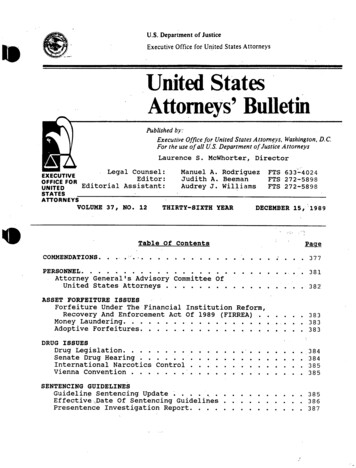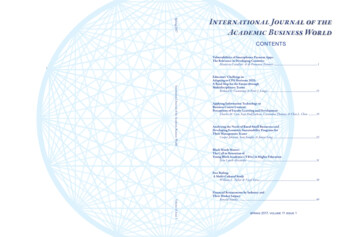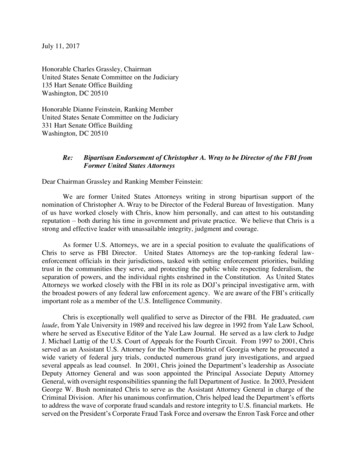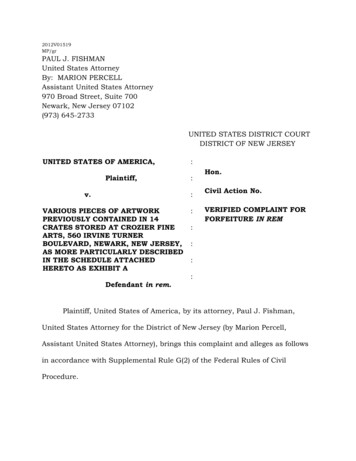
Transcription
UNITED STATES DEPARTMENT OF THE INTERIORGEOLOGICAL SURVEYGeologic controls of uranium deposition,Karnes County, TexasByKendell A. DickinsonOpen File Report 76-331This report is preliminary and has notbeen edited or reviewed for conformitywith U.S. Geological Survey standardsand nomenclature
ContentsPageAbstract1Introduction0Geologic setting2-2Source rock5Leaching6Transportation-7Host rock7Reductant7Preservation:8Controls for individual osenbrock11Brysch12Mocszygemba-Manka12O WWW? I UJ ! »" " » »" " » »» » » " ""» »»» »»» » »»»Brownr OlWw I clx**' ****""**""****' **********"\ C»13********** ' ****'****' **' ******'" ****'IwLauw and Beiker13Searcy14References cited151
List of illustrationsPageFigure 1. General geologic map of the coastal plain ofsouth Texas -32. Schematic stratigraphic diagram4Plate 1. Geologic map showing ore controls, Karnesuranium area, TexasIn pocket2. Electric-log section-across Rosenbrock uraniumdeposit (profile A-A 1 , pi. 1). Deposit is inKellner channel, of Fashing Clay age, thateroded into the Tordilla Sandstone and the DuboseClay Members of Whitsett FormationiiIn pocket
Geologic controls of uranium deposition,Karnes County, TexasBy Kendell A. DickinsonAbstractThe geologic controls for the formation of the epigenetic southTexas uranium deposits are (1) source rock, (2) leaching, (3) transport, (4) host rock, (5) reductant, and (6) preservation. The primaryuranium source rock for the south Texas deposits is the Miocene Catahoula Tuff. It contains about 2/7 ppm uranium, much lower than normalfor rhyolitic tuffaceous material, and its Th/U is 5.6, also indicatinguranium depletion. The uranium was apparently dissolved during mildlyoxidizing and alkaline conditions associated with dry-climate weathering and caliche formation. Beach and fluvial sandstone units exposedin areas of Catahoula drainage provided subsurface conduits for themovement of uranium-bearing water into the host rocks. For a fewdeposits the uranium-bearing water was transported mainly in streamsor along joints and faults. Fluvial and beach sandstone deposits inthe Whitsett Formation of the upper Eocene Jackson Group are the mainhost rocks. Some mudstone and lignite units in contact with the sandstone units also contained ore. Carbonized wood, found in or near mostof the host sandstone bodies, was apparently sufficient for a chemicalreductant; but, for some of the deposits, nearby oil and gas fieldssuggest that petrolic gases may have caused the reduction necessaryfor the precipitation of the uranium. The deposits were preserved aslong as they were not invaded by large quantities of oxidizing groundwater or destroyed by erosion.
Geologic controls of uranium deposition,Karnes County, TexasBy Kendell A. DickinsonIntroductionThe geologic controls for the formation of the epigenetic southTexas uranium deposits are (1) source rock, (2) leaching, (3) transport,(4) host rock, (5) reductant, and (6) preservation. The purpose of thisreport is to evaluate and describe each of these controls for the KarnesCounty area (Eargle and others, 1975) and some of the controls forindividual mines in the unoxidized trend. The geology of the oxidizedore mines, which are located about 2 km updip, northwest of the unoxidized trend, is discussed by Bunker and Mackallor (1973).This text is a modified version of a lecture presented onAugust 8, 1975, before the Rocky Mountain Association of PetroleumGeologists,and on November 20, 1975, before a class at the Colorado»School of Mines.Geologic settingThe Karnes County uranium deposits were found in the WhitsettFormation of the upper Eocene Jackson Group (figs. 1, 2). The WhitsettFormation consists of alternating sandstone and mustone members thatare, in ascending order, the Dilworth Sandstone, Conquista Clay,Deweesville Sandstone, Dubose Clay, Tordilla Sandstone, and FashingClay (fig. 2) (Eargle, 1972). The sandstone members were depositedfor the most part in the beach environment and the mudstone members,in lagoonal or continental environments (Dickinson, 1976). Both themudstone and beach members have been transected by sandstone-filledfluvial channels (fig. 2). The Whitsett was deposited on the northwest flank of the Gulf coast geosyncline. The beds thicken and dipgently toward the gulf, to the southeast. Large-scale faultinggenerally parallels the gulf shoreline. Additional information on thestratigraphy of the area may be found in the works of Eargle and hiscoworkers (Eargle and others, 1971; Eargle and Weeks, 1973; Eargleand others, 1975).2
98 CORPUS CHRISTIVGULF OF MEXICOFIGURE I.-GENERALIZED GEOLOGIC MAP OF THECOASTAL PLAIN OF SOUTH TEXAS3.
H.AD/8OD, APRIL I,1976in\.X-* """* * * * .SEDIMENTSManning FormationDilworth sandstonememberConquista clay memberDeweesville sandstonememberDubose clay memberTordilla sandstonememberFashing clay member6Late EoceneFrio ClayQDOOligocene(?)Cofahoula TuffFIGURE 2. SCHEMATIC STRATIGRAPHIC .DIAGRAM.CONTINENTALBAY-LAGOONALCONTINENTAL SEDIMENTSmemberColliham(?)A ii. tFLUVIALBAY- LAGOONAGEMioceneUNIT
Source rockThe ultimate source rock for the uranium in Karnes County and insouth Texas in general is believed to be the Miocene Catahoula Tuff(Eargle and Weeks, 1973). This conclusion is based on (a) the discrepancy between the assumed original uranium content and the presenturanium content of the tuff, "(b) the thorium-to-uranium ratio, and(c) the lack of other potential source rocks. The present uraniumcontent of the Catahoula is about 3 ppm. Fifteen samples from near theManka mine (pi. 1), analyzed by the neutron-activation method, average2.7 ppm uranium. On the basis of 146 radiometric measurements, Duex(1971) found that the Catahoula averaged 3 ppm. According to Adams(1954) the uranium content of acidic volcanic tuffs is about 5.6 ppm,or nearly twice the amount found in the Catahoula. Furthermore,Gottfried, Moore, and Caemerer (1962) reported as much as 45 ppmuranium in alkalic igneous rocks in the Big Bend region of Texas, thesupposed source of the south Texas volcanics. Dickinson (1975) reports10 ppm-uranium and 32 ppm thorium from below the depth of soil leachingin a relatively unaltered ash bed in the Fashing Clay Member of theWhitsett Formation. These figures are believed to represent the originalcontent of the ash, the source of which was probably similar to that ofthe Catahoula Tuff. Moxham (1964) suggested, on the basis of totalcount, airborne radioactive studies, that radioelements have beenRemoved from the Catahoula.A high thorium-to-uranium ratio in the Catahoula may indicate aloss of uranium. This conclusion is based on the assumption thatthorium and uranium are present in alkalic igneous rocks in a ratioof about 3 or 4 times more thorium than uranium (Adams, 1954). Thethorium is believed to be more stable in the source rock, and it tendsto remain in the source rock when the uranium is leached. The averageTh/U for 15 samples analyzed by neutron-activation of the Catahoulaat the Manka mine is 5.6. The Th/U calculated from the radiometricdata of Duex (1971) is 3.0 and does not indicate preferential uraniumleaching.
Another source suggested by Weeks and Eargle (1963) is tuffaceousmaterial in the Jackson Group. Thirty-nine samples of tuffaceous mudstone from the Whitsett Formation that were analyzed by neutronactivation averaged 13 ppm uranium, and the Th/U averaged 2.4, suggestingthat the tuffaceous material-of the Whitsett did not substantially contribute to the uranium deposits.An oxidized ore trend parallels the unoxidized trend about 3 kmto the northwest. The weathering in this trend probably provideduranium-bearing water that fed some of the unoxidized deposits andformed a secondary source for them. This process may have been similarto Gruner's multiple-migration-accretion hypothesis (Gruner, 1956).The oxidized trend probably represents an earlier unoxidized trend thathas since been partly destroyed by erosion.LeachingThe uranium was apparently leached from the Catahoula Tuff by amoderately oxidizing alkaline solution (Weeks and Eargle, 1963).Garrels (1957) described how these conditions were formed during diagenetic alteration of volcanic glass, and Eargle and Weeks (1973)suggested that these conditions were enhanced by dry-climate weathering.Arid or semi-arid environments have occurred at least intermittentlysince the Miocene in south Texas (Eargle and others, 1975). Uraniumdisequilibrium studies by Rosholt (1959, 1963) indicated that smallamounts of uranium have mobilized and were redeposited as recently as10,000 years ago. Studies of uranium distribution in soils in southTexas by Dickinson (1975) indicate leaching during calichification.Several periods of caliche-weathering probably supplied abundantcarbonate ions to the system, facilitating uranium leaching.
TransportationAfter entering solution, the uranium is transported by surfacedrainage or underground flow to the depositional. site. For near-surfacesites this flow may be largely by streams, and for other sites it may beprimarily or entirely underground. Where underground flow occurs, apermeable rock or a fault acts as a conduit. In Karnes County some conduits are beach sandstone units that trend parallel to the strike orfluvial units that trend obliquely to it. At other deposits joints orlow-displacements faults may have acted as conduits. The sandstone ofthe beach facies is fine grained and well sorted; that of the fluvialfacies is also well sorted but is medium grained.Host rockThe host rock may be nearly the same as the conduit rock, but itis the rock in which the oxidation-reduction front is located at thetime of ore deposition. Typically, however, the uranium enrichmentextends beyond the most permeable rock and may include some siltstoneor mudstone. In fact, some authors (Weeks and Eargle, 1963) have proposed that permeability barriers are an important aspect of a host rockand tend to retard migrating ground water to allow time for the uraniumto precipitate. Large quantities of water must, nevertheless, passthrough the host rock to bring in the uranium.ReductantReductants may be autogenic, generated from within the host rock,or allogenic, coming from outside the host rock. Both kinds may beimportant in Karnes County. Carbonized plant material is a commonautogenic reductant in the uranium host rocks of both beach and fluvialorigin. Weeks and Eargle (1963) have postulated that hydrogen sulfideor some other petrolic gas was an important reductant for the uraniumdeposits of south Texas. Water-soluble organic carbonaceous materialmay also have served as a reductant in some deposits. The gaseous andliquid reductants originated outside the host and are classed asallogenic reductants.
Important geological implications surround the distinction betweenallogenic and autogenic reductants. In the case of autogenic reductants,the reductant is consumed by the continued entrance of oxygenated waterand the oxidation-reduction front migrates. Migration of the frontsproduces large oxidized tongues, typical, for instance, of the Wyomingdeposits. Allogenic reductarrts, on the other hand, are renewable, anda dynamic equilibrium exists between the entrance into the system ofoxygen via the uranium-bearing water and the entrance of reductant froman outside source. With an allogenic reductant a stationary oxidationreduction front can form without the development of an extensive oxidizedtongue. Such a stationary front seems especially likely where a strongallogenic reductant enters through a stationary geologic feature such asa joint or fault. Most unoxidized deposits in Karnes County are foundat about the same depth, about 25 m, which is about the depth of thepresent water table. It is not known where the water table was at thetime of deposition, but the occurrence of many of the Karnes area deposits at the same general elevation suggests a relation to the water table.PreservationThe uranium deposits were preserved as long as they were notinvaded by large quantities of-oxidizing water or destroyed by erosion.Weeks and Eargle (1963) have suggested that a dry climate hasaided in preserving the south Texas uranium deposits. They furthersuggested that the caliche cap that occupies most of the uranium areahelped preserve the deposits by restricting the leaching. The calichecap, which is being destroyed by the present subhumid to semiaridclimate, was radiocarbon dated at 18,000 years old. If a dry climate isnecessary for preservation, then dry climates must have persisted forat least 240,000 years, because many of the deposits are in radioactiveequilibrium. These arguments probably apply only to the deposits within100 or 200 m of the surface. More deeply buried deposits are probablynot affected much by the climate.8
Some of the Karnes County deposits may have been dissolved duringwet periods and redeposited farther downdip perhaps in another sandstone unit near the water table where a reducing environment wasencountered. This process is probably similar to the multiple-accretionhypothesis of Gruner (1956). A large influx of oxidizing meteoricwater for a long period would tend to completely remove the uranium fromthe system. The lack of uranium deposits in the central, more permeableparts of some of the large channel deposits, such as the one in theMiocene Oakville Sandstone, south of Karnes County (Eargle and others,1975), may result from destruction by the movement of large quantitiesof ground water through the deposit. This ground water may also haveprevented the formation of deposits in excessively permeable rocks. Theoxidation of an earlier roll-front deposit in the F. Brysch mine bymovement of large amounts of water through a fluvial sandstone conduitmay represent incipient destruction of this deposit (Dickinson andSullivan, 1976).Controls for individual depositsThe geologic controls for individual deposits in the Karnes areaare discussed below. The name used for each deposit is the name of themine or one of the mines within the deposit. The oxidized depositsalong the Deweesville outcrop are not evaluated in this study.Pfeil The Pfeil deposit extended through the Pfeil, Wright,McGrady, and most of the Weddington mines of Continental Oil Company(pi. 1). The uranium-bearing solutions probably entered through theoutcropping Tordilla Sandstone and through the Kellner channel, whichis of Fashing age. The oxidized tongue lies to the northwest and thereduced area lies to the southeast. The convex side of the ore rollpoints southeastward. The roll-front may have migrated from the outcrop to its present position in response to the downdip movement ofuranium-bearing oxygenated ground water within the Tordilla, but theoffset between this deposit and the Butler-Galen deposit to the northis a strong indication that the deposition was controlled, at least inpart, by the Kellner channel. The Fashing fault was projected into9
the area (Eargle and others, 1975), but there is no proof that itextends that far or, if it does, where it is located. The reductantfor the Pfeil deposit was probably carbonized plant material in or nearthe host rock. No connection between this deposit and a possiblepetrolic reductant is apparent, though it cannot be ruled out. Thegreater downdip migration of this deposit compared with the ButlerGalen deposit may result from a weaker reductant in this area.Butler-Galen The Butler-Galen deposit was mined from a series ofmines beginning on the southwest with the Tenneco part of the Weddingtonand extending northeastward through the Susquehanna part of the Weddington, the Butler, the Turner, and -the Galen mines (pi. 1). Water-bearinguranium leached from the Catahoula entered the deposit via the Kellnerchannel -at the southwest end and through the Tordilla Sandstone Memberfrom its updip outcrop edge. Some uranium may have been dissolved fromor passed through the Pawelek deposit. (See p.,13.) Host rocks arethe Tordilla Sandstone Member and the Kellner channel deposit of theFashing Clay Member. The convex side of the roll lies to the southeastand the oxidized tongue lies to the northwest. In general, the movementof water through the deposit was from northwest to southeast. Movementof uranium-bearing water through the deposit was -restricted along thenortheast end, where porosity was greatly reduced by diagenetic siliceous cement. A well-developed roll was not present in the channelsediment on the Kellner end of the deposit. The reductant was probablycarbonized plant material in the host rock and petrolic gases. Oiland gas-producing holes penetrate the deposit and are found in the areajust north of the deposit (pi. 1).Sickenius Conquista Creek, which drains a large area of Catahoulaterrane, and an area that contained oxidized uranium ore, crosses theTordilla outcrop at the northeast end of the deposit (pi. 1). Theuranium-bearing Conquista Creek waters apparently entered the host rockat or near this juncture. This conclusion ties the age of the oreemplacement to the modern drainage pattern. This tie is further substantiated by disequilibrium between uranium and its daughter productsthat indicates an age less than about a quarter million years for the10
uranium in this mine. During the early mining on this property, onlythe near-surface ore from the northeast part of the mine was removed.This ore was mostly lignite in the lower part of the Fashing ClayMember. Later, unoxidized ore from the Tordilla Sandstone Member wasremoved from the south and west portions of the mine. Siliceous cement,including clinoptilolite and cristobalite, apparently limited mineralization to the southwest along the trend (pi. 1). The siliceous "caprock" in the southwest end of the mine was broken up with explosivesprior to mining.Kellner Uranium-bearing waters from the Catahoula drainage entereda porous channel deposit in the Fashing Clay Member, herein termed theKellner channel (pi. 1), and traveled downdip southeastward to thedepositional site where both medium-grained sandstone and underlyingmudstone deposits were mineralized. The sandstone is well-sorted,medium-grained zeolitized arkose. This ore consisted of three separatebodies and did not conform to the classical ore-roll shape. Althoughthe reductant is largely unknown, carbonized leaves and other matterwere contained in the host rock.Rosenbrock The Rosenbrock uranium ore body was deposited in theKellner channel of the Fashing. Clay Member about three km east of theKellner mine. The ore roll is at a depth ranging from 70 to 90 m.The mine for this deposit is the deepest open-pit uranium mine insouth Texas as of January 1, 1976, and at that time it was still beingstripped. The oxidized side of the ore roll is to the north. Thechannel is eroded into and is at approximately the same stratigraphicposition as the Tordilla Sandstone (pi. 2). The uranium-bearing waterapparently entered the deposit from the Kellner channel, and the rollfront may have migrated down this channel. Lineaments noted on aerialphotographs intersect the deposit. They are believed to be joints orlow-displacement faults that may have affected movement of ground wateror reductants at the deposit. The deposit also lies in a slight downflexed zone (pi. 2).11
Brysch The Brysch deposit was apparently formed where uraniumbearing water of the Conquista Creek flows over the basal ligniteof the Fashing Clay and the Tordilla Sandstone Members. The mine wascompletely filled with water at the time it was seen by the writer,and only the waste piles were available for study.Mocszygemba-Manka The Mocszygemba-Manka deposit (pi. 1) was foundin an area where the Catahoula unconformably overlies the lower partof the Fashing Clay and the Tordilla Sandstone Members. Channels atthe base of the Catahoula were probably important in localizinguranium-bearing ground-water flow. A lignitic layer at the base of theFashing and carbonaceous material in the Tordilla host rock probablyprovided the reductant.Stoeltje The Tordilla Sandstone Member is the host rock for theStoeltje deposit, which lies just north of the Hobson oil field (pi. 1),The Tordilla is overlain by the Fashing Clay Member, which, in turn,is overlain unconformably by fluvial deposits of the Catahoula Tuff.The deposit is transected by joints along which uranium-bearing waterprobably entered. One joint contains a clay deposit ranging from2 to 10 cm in thickness that reportedly predated and locally limiteduranium emplacement. The Tordilla Sandstone Member contains grains ofquartz, feldspar, and volcanic glass, and is weakly cemented withmontmorillonite. The sandstone is largely crossbedded and containsOphiomorpha and clasts of lignite and clay. The mudstone unit overlying the basal lignitic layer of the Fashing Clay in the Stoeltjemine is saturated with water-soluble organic matter (J. Leventhal,oral commun., 1975) that may have been the reducing agent for thisore body. The organic material is leached out in the vicinity of thejoints. The proximity of the Hobson oil field suggests a petrolicreductant, but the abundance of organic material indicates otherwise.The configuration of the ore roll was somewhat contorted and is notcompletely known to the writer.12
Brown The Brown deposit is geologically situated similarly to theMosczygemba-Manka deposit. The Catahoula, with fluvial channels at itsbase, unconformably overlies the Fashing Clay Member. The channels inthe base of the Catahoula seem to have been important in localizing themineralization. The host rock, unlike that in most of the Karnes areadeposits, consists of thinly'interbedded sandstone or siltstone andclaystone. The host rock may have been laid down under tidal-flat orlacustrine conditions.Pawelek The uranium host rock in the Pawelek deposit (pi. 1)was mostly a lignite at the base of the Fashing Clay Member thatdirectly overlies the Tordilla Sandstone Member. A small body ofoxidized uranium ore was removed from the sandstone below the lignite.The average depth to the ore was about 15 m. The host rock was abovethe water table. Uranium-bearing water from the Catahoula terraneapparently entered along the outcrop of the Fashing Clay Member, perhaps through the lignite itself.L'auw and Beiker The Lauw and Beiker deposits are discussedtogether, even though they are nearly 1 1/2 km apart (pi. 1), becausethe host rocks are both channel deposits believed to be part of thesame channel. This channel is in the Dubose Clay Member and is hereintermed the Lauw channel. It may have eroded in places into the underlying Deweesville Sandstone Member. The uranium-bearing water probablyentered the channel deposit in the area east of Tordilla Hill, where itapparently crops out. The channel deposit has not been definitelyrecognized in surface exposures owing to soil cover in the area, but asmall outcrop of crossbedded sandstone (Twdc, pl.l) in a roadcutalong highway FM 791 at the base of Tordilla Hill may be in this channel. The uranium was in an ore roll that is unoxidized on the northwestside, opposite of the other rolls in the Karnes area. The updip movement of the uranium water was probably caused by the movement of thewater from the Lauw channel to the stratigraphically lower DeweesvilleSandstone Member. The reductant in these deposits is probably thecarbonized wood in the host rock. The channel sandstone is fine tomedium grained, is crossbedded, and contains Ophiomorpha, suggestingthat the channel was a distributary channel not far from the coast.13
Searcy The Searcy deposit lies in the divide between Conquistaand Scared Dog Creeks, just south of the Lucket deposit, an oxidizedore body in the Deweesville. The host rock for'the Searcy is alsothe Deweesville, and the uranium-bearing water probably resulted fromsolution of uranium during weathering of deposits in the oxidizedtrend approximately 100 m to the northwest. The Deweesvi.ile Sandstonewas deposited in a beach and back-beach environment. It containsabundant carbonized plant matter, an ample source of reductant. Theconfiguration of the'roll in this deposit is controlled by a thin mudstone unit within the beach sequence, believed to have been depositedin a hurricane washover or tidal'pond.14
References citedAdams, J. A. S., 1954, Uranium and thorium contents of volcanic rocks,Chapter 2 in Nuclear Geology: John Wiley and Sons, New York, 414 p.Bunker, C. M., and Mackallor, J. A., 1973, Geology of oxidized uraniumore deposits of the Tordilla Hill-Deweesville area, Karnes County,Texas; a study of a district before mining: U.S. Geol. SurveyProf. Paper 765, 37 p.Dickinson, K., 1975, Uranium, thorium, soil profiles, and sources rocksin south Texas, in Craig, L. C., Brooks, R. A., and Patton, P. C.,eds., Abstracts of the 1975 Uranium and Thorium Research andResources Conference: U.S.'Geol. Survey Open-file Report 75-595,p. 13.1976, Sedimentary depositional environments of uranium andpetroleum host rocks of the Jackson Group, south Texas: U.S. GeolSurvey Jour. Research (in press).Dickinson, K., and Sullivan, M. W., 1976, Geology of the Brysch uraniummine, Karnes County, Texas: U.S. Geol. Survey Jour. Research (inpress).Duex, T. W., 1971, K/Ar dates and U, K geochemistry of Gueydan (Catahoula) Formation, jj Adams, J. A. S., ed., Final Report: U.S.A.E.G.Research Contract n. AT (05-1J-935, pt. 7, p. 101-145.Eargle, D. H., 1972, Revised classification and nomenclature of theJackson Group (Eocene), south-central Texas: Amer. Assoc.Petroleum Geol. Bull. v. 56, no. 3, p. 561-566.Eargle, D. H., Dickinson, K. A., and Davis, B. 0., 1975, South Texasuranium deposits: Amer. Assoc. Petroleum Geol. Bull, v. 59,no. 5, p. 766-779.Eargle, D. H., Hinds, G. W., and Weeks, A. M. D., 1971, Uraniumgeology and mines, south Texas: Texas Univ. (Austin), Bur.Econ. Geology Guidebook, no. 12, 61 p.Eargle, D. H., and Weeks, A. M. D., 1973, Geologic relations amonguranium deposits, south Texas coastal plain region, U.S.A., inG. C. Amstutz and Bernard, A. J., eds., Ores in sediments:Union Geol. Sci., p. 101-113.15
Garrels, R. M;, 1957, Geochemistry of sandstone-type uranium deposits,j Dunning, J. R., and Prentice, B. R., eds., Advances in NuclearEngineering, v. 2, Nuclear Engineering and Sci. Cong., 2nd,Philadelphia, 1957, Proc.: New York, Pergamon Press, p.288-293.Gottfried, D., Moore, R., and Caemmerer, A., 1962, Thorium and uraniumin some alkalic igneous rocks from Virginia and Texas, in Shortpapers in geology, hydrology and topography: U.S. Geol. SurveyProf. Paper 450-B, p. B70-B72.Gruner, J. W., 1956, Concentration of uranium in sediments by multiplemigration-accretion: Econ. Geology, v. 51, p. 495-520.Moxham, R. M., 1964, Radioelement dispersion in a sedimentary environment and its effect on uranium exploration: Econ. Geology, v. 59,no. 2, p. 309-321.Rosholt, J. N., Jr., 1959, Natural radioactive disequilibrium of theuranium series: U.S. Geol. Survey Bull. 1084-A, p. 1-30.1963, Uranium in sediments: U.S. Geol. Survey Open-file report,211 p.Weeks, A. M. D., and Eargle, D. H., 1963, Relation of diageneticalteration and soil-forming processes to the uranium depositsof the southeast Texas coastal plain, ir Clay Minerals, 1961,Proc.: New York, Macmillam Co. (Internat. Ser. Mons. Earth Sci.,v. 12), p. 23-41.16
Plate 1. Geologic map showing ore controls, Karnes uranium area, Texas In pocket 2. Electric-log section-across Rosenbrock uranium deposit (profile A-A1 , pi. 1). Deposit is in Kellner channel, of Fashing Clay age, that eroded into the Tordilla Sandstone and the Dubose Clay Members of Whitsett Formation In pocket ii











